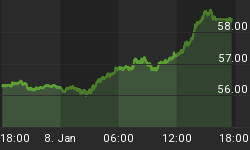The reliance upon the U.S. dollar as the world's reserve currency and "safe haven" asset has created a perverse, but deeply entrenched, mindset among global investors. In fact, many believe the major financial players have no alternatives to owning U.S. debt and dollars. They argue that the market for U.S. dollars and Treasuries is the only financial pool large enough to handle the massive liquidity that sloshes around the globe on a daily basis. This idea makes a mass exodus from U.S. debt holdings seem impossible. This provides a nice explanation why the U.S. Treasury bonds can rally even while the government openly flirts with default and ratings agencies issue downgrades. But just because an illogical event occurs habitually does not mean it is logical or tenable.
The sophomoric reasoning behind the dollar "exceptionalism" argument is like assuming a stock can never fall unless a significant portion of shareholders decide to sell. In reality, a buyers strike is all that is needed to puncture a market. If the U.S. experienced just one disastrous Treasury auction, prices could nose-dive and yields could skyrocket across the board on all U.S. debt.
But the problem doesn't just lie with the United States. Investors around the world are finally beginning to understand that central bank's thirst for creating inflation, in order to keep their banks and governments solvent, will never be quenched.
This week, the Swiss government took action to weaken the surging franc by lowering interest rates and printing currency. The franc was pushed down briefly, but then snapped back. It's hard to keep a good currency down. Similarly, the Bank of Japan announced that it won't stand for Yen appreciation much longer and would likely soon intervene to buy dollars and weaken the Yen.
Meanwhile, problems at the overly indebted countries just get worse. Italian and Spanish debt yields are now following the upward spiral of Greek bonds (and hitting multi year highs). Italian ten-year notes have surged from just above 3% in late 2010 to well over 6% today. For a country whose debt to GDP ratio is currently over 120%, a doubling of interest rate expenses spells disaster.
Enter Jean Claude Trichet who will certainly use his printing press to buy much of the weakening Italian debt that is now festering on the balance sheets of the biggest European banks. But the size of the bailouts needed to deal with Italian and Spanish debts will be several orders of magnitude greater than those needed for Ireland or Greece. Anticipating a massive increase in the Euro money supply, investors are flocking to gold to protect themselves from currency debasement.
Adding fuel to the gold fire is the recent debt deal reached in Washington. The disgusting agreement virtually assures that over the next decade the U.S. will add an additional $8 trillion in public debt, an increase of nearly 80% in ten years! The back-end-loaded deal will cause the amount of deficit reduction to be just $21 billion in 2012 and $42 billion in 2013.
But even this modest debt reduction depends on rosy assumptions from Washington that are always wrong. For example, the Obama administration predicts GDP growth will average well over 3% for the coming decade. But the annualized GDP growth in the first half of 2011 was just 0.9%. That means the actual deficit and debt figures will be far greater than the projections. Given the immediate increase in borrowing needs, and the obvious slowing of the tepid "recovery," there can be little doubt that the next round of quantitative easing will be launched sooner rather than later.
The incompetency of U.S. credit rating agencies has long been suspected. But their actions in the wake of the debt ceiling agreement now confirm them as liars. After threatening to downgrade U.S. credit if Washington failed to cut $4 trillion in spending, neither Moody's, Fitch nor S&P had the courage to carry through, despite the fact that the total cuts would amount to only half their requirements. But a credit rating downgrade on Treasuries did come-from China. The Dagong Global Credit Rating agency cut the credit rating on U.S. sovereign debt to A from A+, 5 notches below AAA. And since the Chinese are the biggest foreign buyer of Treasuries, their opinion counts.
This week, more evidence of U.S. stagflation emerged. The ISM manufacturing and non-manufacturing reports showed a slowdown in new orders and employment and the ADP report showed that the U.S. lost 7,000 goods-producing jobs in July. Other data releases showed that layoffs surged 60% last month to a 16-month high. Meanwhile, YOY consumer prices are up 3.6% and M2 money supply is up 7.5% YOY and rising at a 14.6% annual rate in the last quarter. As the problem with stagflation becomes worse, international investors will avoid the U.S. dollar and U.S. debt at an ever increasing rate.
With soaring debt-to-GDP ratios in Japan, Western Europe and America, the desirability of owning precious metals will grow as investors realize the fiat currency system's days are numbered. Those holding U.S. dollars and U.S. debt will feel the biggest brunt of the change. But it is always darkest before the dawn. As a result of the carnage the re-establishment of gold as the world's reserve currency is, hopefully, only a few years away.
Subscribe to Euro Pacific's Weekly Digest: Receive all commentaries by Peter Schiff, Michael Pento, and John Browne delivered to your inbox every Monday.
Follow Michael Pento's blog on his Pentonomics column.
For a great primer on economics, be sure to pick up a copy of Peter Schiff's hit economic parable, How an Economy Grows and Why It Crashes.
















